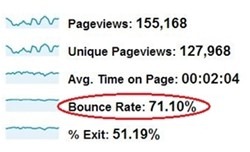Blogging can be a lonely business. You write and publish post after post in the hope of attracting more traffic, and in turn more revenue, but with little or no information as to who is reading your blog, how they are finding you and most importantly how you can generate more visits. Free to use, Google Analytics is undoubtedly one of the best performing web analytics applications available and it can be an invaluable tool to help make your blog work harder. This essential analytics guide will help you get the best out of this powerful program.
What is Google Analytics?
Google Analytics tracks online traffic and generates detailed statistics about visits to a website or blog. An invaluable tool for bloggers, it is the most popular and widely used service for analyzing website statistics. In addition to the free program, a premium version is available for a fee.
It offers a quick and easy way to find out who is visiting your blog, what devices they use to view your blog, how long they stay on your site, and whether or not they are new visitors. This invaluable information will help you make informed decisions about the effectiveness of your posts and potential areas for content development. You should be able to use Google Analytics on most common blog and content management systems.
How does it work?
Google Analytics provides a tracking code which, when added to every page on your blog, collects and reports on visitor data obtained from a client’s browser, including whether a visitor has visited your site before and where they were referred from e.g., pay per click networks, AdSense or Adwords, search engines and online advertising.
The report displays an overview of your website’s traffic patterns within a specific date range or choice of date ranges which you can then review and compare for patterns, spikes, drops etc. Overviews and detailed reports for traffic sources, content, and conversions are also available, as are custom reports which enable users with specific analysis needs to choose their metrics and how they are displayed, for example in a table, graph, chart etc.

How can the data help my blog?
Understanding your blog traffic is key to developing, growing and maintaining your audience as well as enhancing your blog’s performance and content. Google Analytics data can also help you attract advertisers and sponsors and boost sales on associated websites. The following are the key insights you can expect to find:
- Visitors – new visitors are great, frequent repeat visitors are even better. They like what you do, are influenced by your content and are interested in getting the latest updates from you. By reviewing the “days since last visit” report on Google Analytics you can identify useful patterns such as time or day of visit and predict future visits to ensure your updates are timely.
 Bounce rate – a bounce is when a visitor only views one page on a website before leaving. A low bounce rate means that visitors to your blog are engaged in your content; conversely a high bounce rate suggests that people leave having not found what they were looking for on your website.
Bounce rate – a bounce is when a visitor only views one page on a website before leaving. A low bounce rate means that visitors to your blog are engaged in your content; conversely a high bounce rate suggests that people leave having not found what they were looking for on your website.- Visit value – visit duration and the page depth (how many pages a visitor viewed) are two important metrics available on Google Analytics that will tell you how long people visit your blog for and how many pages they viewed whilst there. Your ultimate aim is to generate a high number of visitors who each view more than one page, and stay on your site for more than a few seconds.
- Traffic - understanding where your traffic comes can be powerful. Try togenerate traffic from a variety of sources, that way you are not reliant on one specific source and are protecting yourself from a drop in traffic should that source unexpectedly close or change. Google Analytics can help you determine the strength of your search engine optimization (SEO), as well as incoming links, and effectiveness of advertising campaigns.
Is it difficult to install?
As a blogger you will already be familiar with your blog dashboard, and with some basic techniques such as installing widgets and plugins. You will also need to ensure that you input the tracking code on every page to get the best out of it so follow the installation instructions carefully. Google Analytics should be suitable for most common blog platforms and content management systems, but if in doubt review your blog help topics and search forums for installation tips.





0 Comments